In the region of Goetz’s Castle Hornberg
But now once again a castle dominates far into the valley; Hornberg Castle near Neckarzimmern, one-time residence of Goetz von Berlichingen, bought by him for 6.000 gulden in 1517, that is to say several years before the Peasants' War. From here he took the field as leader of the peasants and it was here he returned after the collapse of the revolt and after several years' imprisonment, to a certain extent still a prisoner for he was only allowed to move about in the immediate surroundings. It was in this castle that Goetz wrote his memoirs which gave Goethe the material for his play "Goetz von Berlichingen”, through which the story of the knight with the iron hand was once again recived for the world. In 1562 the grim old soldier died at the age of 82. In 1504 he lost his hand before Landshut and had it replaced by the famous iron hand still to be seen in Jagsthausen. Goetz's armour, on the other hand, is the most splendid piece in the collection of antiques on view in the later building at Hornberg. It shows that Goetz was not of tall stature but only “thick-set”. The last Berlichingen of this line Berlichingen -Rosseck died only a few years after the first world war in Heidelberg.
From older history it is known that the castle belonged in the 11th and 12th centuries to the very well-to-do Counts von Laufen and was probably also built by them. It has often changed its owners since then until in 1612 it came to the family of the Barons von Gemmingen who, however, found no proper accomodation in the ruins and therefore moved to the simple castle in Neckarzimmern. It was only later that new living quarters were built above.
Today the large and splendid Hornberg Castle, of which very considerable parts are in a good state of preservation, is a jewel among the treasures of the Neckar. It presents a splendid view and is itself visible from a great distance. Whoever visits it and closely regards the courtyards, gateways and towers, and looks at the already mentioned collection in the house of the family von Gemmingen-Hornberg, will leave Hornberg with a deep feeling of satisfaction. Goetz’s spirit still lives in these beautiful castle ruins, but even alone it is a proud and magnificent building. Its big semi-circular tower is the landmark of this landscape. Friendly Neckarzimmern at the foot of the castle rightly praises the wine coming from the slopes around the castle and at the same time it is an industrial spot with gypsum works whose material was formerly taken From the Hornberg.
As we continue our wanderings in the open and sun-filled valley numerous beautiful spots emerge: to the right, sprawling behind a long row of poplars, the big boatmen's village of Haasmersheim, whence come, except during the winter months, most of the boatmen and many boatwomen, too, who navigate the Neckar, Rhine and the West German network of canals; to the left the much frequented pilgrim chapel of St. Michael. Before the huge Neckar loop lies the little village of Böttingen, to the right, beyond the loop, Neckarmühlbach with the proud Guttenberg Castle above it and just afterwards, now again on the other side, Castle Horneck with the little town of Gundelsheim. This is a real Garden of Eden with its beauty and fertility. For more than 500 years the Barons von Gemmingen-Guttenberg could keep in their family possession Guttenberg Castle with its particularly stately old and new buildings, and a huge high watch tower overtopping it. It is worth while to find the way there, to view the castle and mount its tower, and many may find the little church lying half way up the hill worth looking at. There are artistic tombstones and line woodcarvings to be seen here. Wilhelm Hauff's charming tale "Das Bild des Kaisers" - "The Emperor's Picture" — is set here, telling the story of a picture of Napoleon and a young love.
The old Castle Horneck, formerly belonging to an Order, in earliest times probably a strong fort with a powerful tower, is now a national sanatorium after having been a well-known private sanatorium for a long time. But the castle and beautifully laid-out park can still be viewed and the adjoining little town of Gundelsheim also offers many sights worth seeing, its ancient corners, the remains of the old town fortifications and the delightful streets. From the old days of the towering fort documents tell us that in the 12th century the lords of Horneck together with the Counts von Laufen had a share in the possession of the neighbouring Hornberg. However, in the middle of the 13th century Horneck became a castle of the Teutonic Order.
From older history it is known that the castle belonged in the 11th and 12th centuries to the very well-to-do Counts von Laufen and was probably also built by them. It has often changed its owners since then until in 1612 it came to the family of the Barons von Gemmingen who, however, found no proper accomodation in the ruins and therefore moved to the simple castle in Neckarzimmern. It was only later that new living quarters were built above.
Today the large and splendid Hornberg Castle, of which very considerable parts are in a good state of preservation, is a jewel among the treasures of the Neckar. It presents a splendid view and is itself visible from a great distance. Whoever visits it and closely regards the courtyards, gateways and towers, and looks at the already mentioned collection in the house of the family von Gemmingen-Hornberg, will leave Hornberg with a deep feeling of satisfaction. Goetz’s spirit still lives in these beautiful castle ruins, but even alone it is a proud and magnificent building. Its big semi-circular tower is the landmark of this landscape. Friendly Neckarzimmern at the foot of the castle rightly praises the wine coming from the slopes around the castle and at the same time it is an industrial spot with gypsum works whose material was formerly taken From the Hornberg.
As we continue our wanderings in the open and sun-filled valley numerous beautiful spots emerge: to the right, sprawling behind a long row of poplars, the big boatmen's village of Haasmersheim, whence come, except during the winter months, most of the boatmen and many boatwomen, too, who navigate the Neckar, Rhine and the West German network of canals; to the left the much frequented pilgrim chapel of St. Michael. Before the huge Neckar loop lies the little village of Böttingen, to the right, beyond the loop, Neckarmühlbach with the proud Guttenberg Castle above it and just afterwards, now again on the other side, Castle Horneck with the little town of Gundelsheim. This is a real Garden of Eden with its beauty and fertility. For more than 500 years the Barons von Gemmingen-Guttenberg could keep in their family possession Guttenberg Castle with its particularly stately old and new buildings, and a huge high watch tower overtopping it. It is worth while to find the way there, to view the castle and mount its tower, and many may find the little church lying half way up the hill worth looking at. There are artistic tombstones and line woodcarvings to be seen here. Wilhelm Hauff's charming tale "Das Bild des Kaisers" - "The Emperor's Picture" — is set here, telling the story of a picture of Napoleon and a young love.
The old Castle Horneck, formerly belonging to an Order, in earliest times probably a strong fort with a powerful tower, is now a national sanatorium after having been a well-known private sanatorium for a long time. But the castle and beautifully laid-out park can still be viewed and the adjoining little town of Gundelsheim also offers many sights worth seeing, its ancient corners, the remains of the old town fortifications and the delightful streets. From the old days of the towering fort documents tell us that in the 12th century the lords of Horneck together with the Counts von Laufen had a share in the possession of the neighbouring Hornberg. However, in the middle of the 13th century Horneck became a castle of the Teutonic Order.
Dieses Kapitel ist Teil des Buches The Neckar Valley. From Heidelberg to Wimpfen
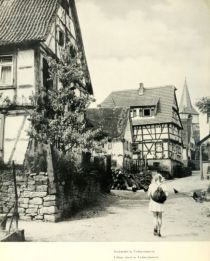
048 Dorfstraße in Neckarzimmern
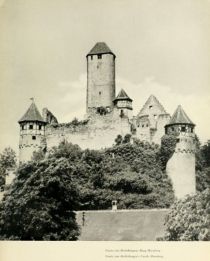
049 Goetz von Berlichingens Burg Hornberg
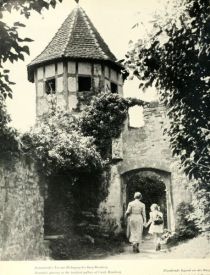
050 Romantische Tor am Wehrgang der Burg Hornberg
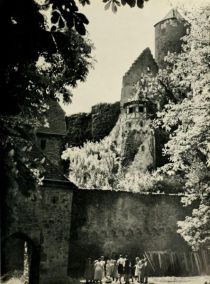
051 Burg Hornberg
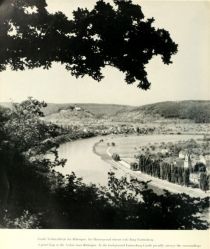
052 Große Neckarschleife bei Böttingen. Im Hintergrund thront stolz Burg Guttenberg
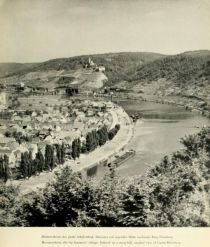
053 Haßmersheim, das große Schifferdorf. Dahinter auf ragender Höhe nochmals Burg Hornberg
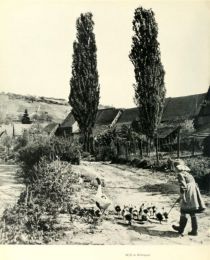
054 Idyll in Böttingen
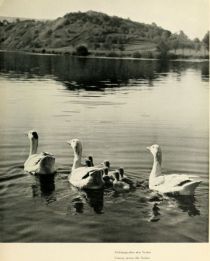
055 Geleitzug über den Neckar (Gänsefamilie)
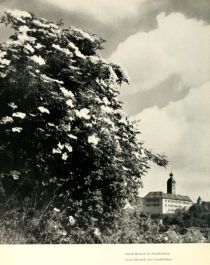
056 Schloss Horneck bei Gundelsheim
alle Kapitel sehen